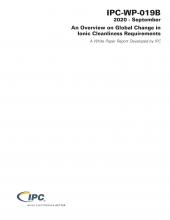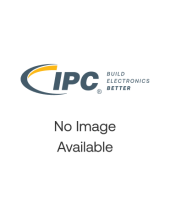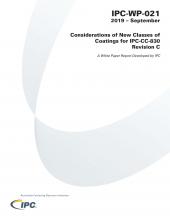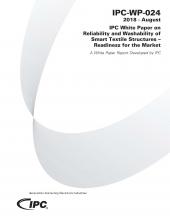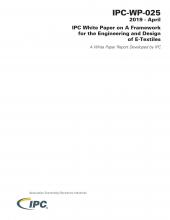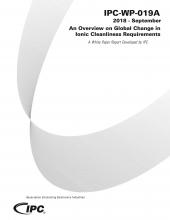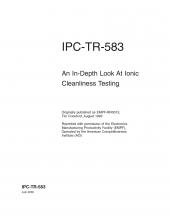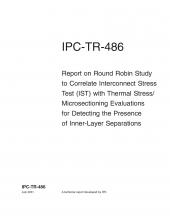Products
The IPC-WP-019B white paper was created to support the IPC-J-STD-001H standard and provides additional guidance, examples, and understanding of Section 8.0 Cleaning and Residue Requirements. The IPC-WP-019B has information on how to meet the requirements of IPC-J-STD-001H chapter 8. Recommentded for those looking to implement the requirements of IPC-J-STD-001H standard, chapter 8. 0..
IPC-WP-023 is an IPC Technology Solutions White Paper addressing reliability issues associated with stacked microvias. There is evidence that staggering vias can result in a more robust structure; however, staggering microvias is only a temporary solution to accommodate complex designs with microvias built with weak interface structures IPC-WP-023 white paper provides an investigation of these...
The IPC-WP-021 white paper considers conformal coatings, like many high-performance materials, have evolved considerably since the 1990s. New coatings, such as fluoropolymers or hybrid coatings, have come on the market, many of which offer superior protection characteristics, but do not fit into the existing classifications of either MIL-I-46058 or IPC-CC-830. The IPC-WP-021 white paper discusses...
IPC-WP-024 is a white paper which discusses the issues associated with reliability of smart textiles (e-textiles structures) following multiple washing cycles and emphasizes efforts that industry and research laboratories must undertake to make e-textile structures more robust and able to be washed similarly to everyday textile products (e.g., underwear, clothing, home textiles and technical...
Manufacturers of high reliability electronics have been working for many years to mitigate the deleterious effects of tin whisker formation. One highly effective means to suppress the growth of tin whiskers is to replace the pure tin plating with reflowed tin-lead solder. One approach is to fully consume the tin plating by tin-lead solder during the SMT reflow process. This phenomenon of tin...
This white paper is a benchmarking exercise of e-textile integrations, providing an introductory categorization of how the current market sector is using textile-based electrical components to achieve integrated functionality. This peer assessment provides a baseline understanding of e-textile process techniques, requirements and resources within this emerging sector.
The IPC Solder Products Value Council’s Technical Subcommittee Report “Take Action Limits (TAL) for SAC305 Lead Free Soldering Processes Utilizing Solder Baths/Pots” reports on research on take action limits of solder pot contamination for SAC305 lead-free solder. As opposed to one maximum contamination level, the IPC SPVC opted to identify three action levels: Normal operation defined as the...
A discussion was held in the 5-33AWG (ad hoc working group), on things that conformal coat professionals (materials and processes) wish designers knew about conformal coating. The 5-33AWG group is comprised of individuals from OEMs, coating suppliers, and test lab personnel.
IPC-WP-019A a revised white paper provides an overview of ionic cleanliness requirements, providing examples of tests and requirements for acceptability from a residue/cleanliness standpoint. The history of ROSE testing is also provided, with explanations of the shortcomings of that testing.
IPC-TR-587 technical report delivers results of a major study on conformal coating. In most manufacturing specifications, conformal coating thickness is defined as the thickness of the final polymer film on a flat, unencumbered surface of the assembly, however conformal coating thickness on other assembly and component surfaces is not characterized. IPC-TR-587 is a report outlining an IPC study of...
This document details the test procedures, test results and team conclusions for the IPC Cleaning and Cleanliness Testing Program, Phase 3, Low Solids Flux in Ambient Air. This effort has been part of a multi-stage program to investigate material and process alternatives to the use of chlorofluorocarbons (CFCs) in electronics manufacturing. This Phase 3 effort has been dedicated to characterizing...
This original research was a cooperative effort between the EMPF and IPC, released as EMPF-RR-0013 in 1993 for better understanding of ionic cleanliness testing. The IPC Ionic Conductivity/Ion Chromatography Test Task Group has validated its continued importance and relevance to the cleaning community and IPC-TR-583 is the result. It includes how solvent temperature influences the final...
This technical report provides full detail of the round robin study charged with assessing the use of Interconnect Stress Test (IST) as a test for incoming inspection in lieu of Thermal Stress in the detection of innerlayer separations in plated-through holes. Includes background on the Post Separation Task Group, test results, round robin test plan, conclusions and test methods used. 51 pages...
Details the results of a two-year study to determine the effect of steam aging exposure on components. A variety of solderable finishes were used. A small production simulation utilized preconditioned and as-received samples and tested a total of 2,000 joints. 15 pages. Released July 1996.
This addendum to J-STD-001, originally developed for Revision B but also applicable to Revision C, proposes solutions for cost-effective testing and increased implementation. Also covers other assembly test methods that are not addressed in J-STD-001. 12 pages. Released October 1996. Now available in electronic format.
A Technical Paper by Dr. Jack Brous discussing ionic cleanliness measurement, testing methods and cleanliness standards in relation to product reliability. Also includes a brief discussion of no-clean fluxes. 8 pages. Released 1994
IPC-TR-587 technical report delivers results of a major study on conformal coating. In most manufacturing specifications, conformal coating thickness is defined as the thickness of the final polymer film on a flat, unencumbered surface of the assembly, however conformal coating thickness on other assembly and component surfaces is not characterized. IPC-TR-587 is a report outlining an IPC study of...
本白皮书 IPC WP-019B 旨在支持 J-STD-001 修订版 H,并提供额外的指导、示例和对第 8.0 节清洁和残留物要求的理解。 推荐给那些希望实现 J-STD-001 8.0 要求的人。
IPC-WP-019A, un libro blanco revisado que proporciona una visión de conjunto sobre los requisitos de limpieza iónica, junto con ejemplos de pruebas y de requisitos para la aceptabilidad en cuanto a limpieza o presencia de residuos. Presenta también un resumen de la historia de la prueba de ROSE junto con explicaciones sobre las limitaciones de esta prueba.
La révision du livre blanc IPC-WP-019A présente les exigences en matière de propreté ionique, avec des exemples de tests et d’exigences pour l’acceptabilité du point de vue des résidus/de la propreté. Un historique des tests ROSE est également fourni, accompagné d’explications relatives aux défauts que présentent ces tests.
IPC-WP-019A ist ein revidiertes Whitepaper mit einem Überblick über die Anforderungen an ionische Reinheit, das Beispiele für Tests und Abnahmekriterien unter dem Blickwinkel von Flussmittelrückständen/Reinheit enthält. Die Geschichte des ROSE-Testverfahrens wird ebenfalls geschildert, und die Nachteile dieses Verfahrens werden erläutert.
This document provides an overview of ionic cleanliness requirements, providing examples of tests and requirements for acceptability from a residue/cleanliness standpoint. The history of ROSE testing is also provided, with explanations of the shortcomings of that testing.
This technical report provides the documentation of a round robin testing effort that generated data used by the 4-14 Plating Processes Subcommittee in developing the maximum immersion silver plating thickness requirement in the revision A of IPC-4553. This compendium of data resulted from three information sets: a) Test vehicle assembly report by Celestica, b) Thermal cycle test report by...
IPC-WP-024是一份白皮书,讨论了多次洗涤循环后智能织物(电子织物结构)可靠性相关的问题,并强调了工业和研究实验室必须做出的努力。以使电子织物结构更加坚固,能够像市场上的日常织物(例如,内衣、服装、家用织物和技术织物)一样被清洁或洗涤。 研究人员在商用洗衣机和家用洗衣机洗涤剂多次洗涤循环后,为电子织物提供实验室测试的初始可靠性结论。
Coming Soon
IPC-7095E: Design and Assembly Process Implementation for Ball Grid Arrays (BGAs)
IPC-2294: Design Standard for Printed Electronics on Rigid Substrates
IPC-6904: Qualification and Performance Specifications for Printed Electronics on Rigid Substrates
J-STD-005B: Requirements for Soldering Pastes
IPC-4105: Specification for Metal Base Copper Clad laminates for Rigid Printed Boards
J-STD-004D: Requirements for Soldering Fluxes
IPC-4413: Specification for Finished Fabric Woven from Low Dk Glass for Printed Boards

